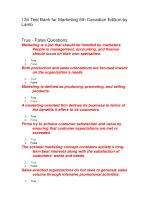patents for beginners 5th (2006)
Bạn đang xem bản rút gọn của tài liệu. Xem và tải ngay bản đầy đủ của tài liệu tại đây (1.56 MB, 232 trang )
Nolo’s
Patents for
Beginners
by Attorneys David Pressman
and Richard Stim
5th edition
Nolo’s Legal Updater
We’ll send you an email whenever a new edition of this book
is published! Sign up at www.nolo.com/legalupdater.
Updates @ Nolo.com
Check www.nolo.com/update to fi nd recent changes
in the law that aff ect the current edition of your book.
Nolo Customer Service
To make sure that this edition of the book is the most
recent one, call us at 800-728-3555 and ask one of
our friendly customer service representatives.
Or fi nd out at www.nolo.com.
e law changes, but Nolo is on top of it! We off er several
ways to make sure you and your Nolo products are up to date:
always up to date
2
1
3
We believe accurate, plain-English legal information should help
you solve many of your own legal problems. But this text is not a
substitute for personalized advice from a knowledgeable lawyer.
If you want the help of a trained professional—and we’ll always
point out situations in which we think that’s a good idea—consult
an attorney licensed to practice in your state.
please note
Nolo’s
Patents for
Beginners
by Attorneys David Pressman
and Richard Stim
5th edition
FIFTH EDITION MAY 2006
Editor RICHARD STIM
Book Design TERRI HEARSH
Proofreading SUSIE SEEFELT LESIEUTRE
Index ELLEN SHERRON
Printing DELTA PRINTING SOLUTIONS, INC.
Pressman, David, 1937–
Nolo’s patents for beginners / by David Pressman and Richard Stim 5th ed.
p. cm.
ISBN 1-4133-0455-9 (alk. paper)
1. Patent laws and legislation United States Popular works. 2. Patent
practice United States Popular works. I. Title: Patents for beginners. II. Stim, Richard.
III. Title.
KF3114.6.P737 2006
346.7304’86 dc22
2006040060
Copyright © 1998, 2000, 2001, 2002, 2004, and 2006 by Nolo and David Pressman.
ALL RIGHTS RESERVED. Printed in the U.S.A.
No part of this publication may be reproduced, stored in a retrieval system, or transmitted in any
form or by any means, electronic, mechanical, photocopying, recording, or otherwise without
prior written permission.
For information on bulk purchases or corporate premium sales, please contact the Special Sales
Department. For academic sales or textbook adoptions, ask for Academic Sales. Call 800-955-4775
or write to Nolo, 950 Parker Street, Berkeley, CA 94710.
About Our Cover
Astrid plays an integral role at Guide Dogs for the Blind
(www.guidedogs.com)—her pups become loyal helpers
and confidence-boosters to visually impaired people.
In much the same way, Nolo books and software will
guide you step by step through the unfamiliar legal
tangles of life’s big events.
Acknowledgments
We would like to thank the knowledgeable and helpful staff at Nolo: Nolo produc-
tion, sales and marketing, public relations, and customer service departments.
Table of Contents
I
Introduction
A. Organization of Text 2
B. Icons Used in This Book 3
1
Patents and Intellectual Property Law
A. What Is a Patent? 10
B. The Three Types of Patents 10
C. Patent Rights 11
D. The Requirements for Obtaining a Patent 12
E. How Long Do Patent Rights Last? 12
F. How Patent Rights Can Be Lost 13
G. Intellectual Property—The Big Picture 13
H. Trademarks 14
I. Copyright 15
J. Trade Secrets 18
K. Unfair Competition 22
2
Qualifying for a Patent
A. Legal Requirements for a Utility Patent 25
B. Statutory Classes 26
C. Utility 30
D. Novelty and Prior Art 32
E. Nonobviousness 40
F. Legal Requirements for a Design Patent 48
G. Legal Requirements for a Plant Patent 51
3
Invention Documentation
A. The Importance of Documentation 54
B. Lab Notebook 55
C. Invention Disclosure 58
D. Documenting Conception: Disclosure Document Program (DDP) 58
E. Documenting Reduction to Practice: Provisional Patent Application 60
F. Trade Secret Considerations 61
4
Patent Searching
A. Principles of Patent Searching 64
B. Hiring a Patent Searcher 65
C. Do It Yourself Searching 67
5
Reading and Writing Patents
A. Elements of a Patent 83
B. Invention and Inventor Data 83
C. Specification 83
D. Claims 94
E. Abstract 99
F. Drawings 100
G. Preparation of a Patent Application 103
6
Patent Prosecution and the PTO
A. Patent Prosecution: The Road to Allowance 116
B. Responding to a Final Office Action 126
C. Additional Application Issues 128
D. Design Patent Prosecution 131
7
Patent Ownership
A. The Inventor Is Initial Owner of Patent Rights 134
B. Employee Inventions 134
C. Joint Owners 140
8
Patent Infringement
A. What Is Patent Infringement? 147
B. Who Can Sue, Who Can Be Sued? 152
C. Stopping Patent Infringement 153
D. Defenses to Patent Infringement 158
E. Ending Disputes Without a Lawsuit 162
9
International Patent Law
A. Introduction to Foreign Patent Treaties and Laws 166
B. Putting It Together: The Most Common Route for U.S.
Inventors Seeking Foreign Patent Coverage 170
C. The Paris Convention and the One-Year Foreign Filing Rule 170
D. The Patent Cooperation Treaty (PCT) 172
E. European Patent Office (EPO) 175
F. Locating Foreign Patent Agents 176
10
Help Beyond This Book
A. Inventor Resources 182
B. Patents and Intellectual Property Resources 183
C. Working With an Attorney 185
Glossary
Index
Introduction
A. Organization of Text 2
B. Icons Used in This Book 3
2 NOLO’S PATENTS FOR BEGINNERS
T
he principles of patent protection
have changed little since 1790. If you
devise a novel invention and qualify
for a patent, you can, for a limited time,
prevent anyone else from making, selling,
or using it. For two centuries, businesses
and inventors have used patent protection
for products, processes, plants, and designs.
However, the technological changes of the
past 20 years have dramatically altered the
patent landscape. The number of utility
patent applications has nearly tripled since
1980. Since 1790, over seven million U.S.
patents have been granted. In fiscal year
2005 (which ended September 30, 2005) the
U.S. Patent and Trademark Office (PTO) re-
ceived 406,302 patent applications.
The explosive growth in biotechnology,
information exchange, and the advent of
business method and software patents has
resulted in more patents being issued than
ever before. Patents are now considered an
integral part of a corporation’s strategic
business plan. And this strategy is not
limited to corporate boardrooms. For
example, the total revenue from patents for
non-profit universities has gone from less
than one million dollars in 1980 to over half
a billion dollars today.
At the same time, the Internet is creating
new avenues of public access to the patent
application process. Anyone with an
Internet connection can now search patent
records at the PTO. Patent forms and rules
can now be easily downloaded. Moreover,
the first electronic filing of a utility patent
occurred in 2000. Even more importantly,
the dramatic advances in technology
around the globe have been an incentive to
getting new changes in U.S. patent law off
the ground.
To stay current with the modern world
of patents, we have created a compact
modern patent guide that explains patent
law and provides clear instructions for
deciphering and searching for patents.
This book is intended for use by inventors,
educators, entrepreneurs, students, and
business people who must deal with and
understand basic principles of patent law.
A. Organization of Text
Chapters are organized into four categories:
basic patent principles, rules for document-
ing and acquiring patent rights, patent
ownership and disputes, and international
patent law. Chapter 10 provides helpful
resources.
• Principles of Patent Law. The first two
chapters explain basic patent prin-
ciples, the types of patents, what can
and cannot be protected, novelty,
nonobviousness, and the statutory
standards for patent protection.
• Documenting, Searching, and Prosecut-
ing Patents.
Chapters 3 through 6 deal
with the invention process and the
manner in which patents are granted
by the PTO. Chapter 3 describes
invention documentation. Chapter 4
describes patent searching, and
Chapter 5 describes how to read and
INTRODUCTION 3
write a patent application. Chapter 6
describes patent prosecution—the
process of shepherding the patent
application through the PTO.
•
Ownership and Patent Disputes. Chap-
ters 7 and 8 discuss the ownership
and protection of patents. Chapter 7
provides information about ownership
rights (for example, how inventors
claim joint ownership and its implica-
tions). Chapter 8 focuses on the issues
of litigating patent disputes and
standards for patent infringement.
• International Law. Chapter 9 provides
rules for international patent protection.
• Resources. We have provided a
Glossary to assist in deciphering
patent law. Additionally, Chapter 10
offers additional inventor and patent
resources.
In order to function as an educational
tool and desktop reference, this book filters
complex material into readable segments.
For instance, important rules regarding
nonobviousness, novelty, and infringement
are summarized and isolated throughout
many chapters. In this manner, the reader is
better able to easily find and digest rules
and procedures.
An instructor using the book as a teach-
ing tool can proceed systematically through
the chapters beginning with principles of
protection, followed by patent application
principles, and culminating with patent
disputes and international patent law. For
students, the material includes current case
law, references, and examples.
Readers seeking a practical application of
patent law will find detailed information on
important patent procedures, including
electronic patent searching, patent prepara-
tion, and international patent law. There are
also extensive Internet references and
resources.
B. Icons Used in This Book
To aid you in using this book, we use the
following icons:
The caution icon warns you of
potential problems.
This icon indicates that the information
is a useful tip.
This icon refers you to helpful books
or other resources.
4 NOLO’S PATENTS FOR BEGINNERS
The Proposed Patent Act of 2005
At the time of publication of this edition,
Congress was considering, but had not yet
approved, a substantial reform of patent
laws. You can track the progress of the
patent reform legislation (H.R. 2795) at the
Thomas website ().
The proposed legislation contains many
important and controversial provisions in-
cluding:
• Adoption of a First-to-File System. As
explained in Chapter 1, U.S. patent
law, unlike the rest of the world, cur-
rently grants patent rights to the per-
son who was the first to invent, not
the one who was first to file for the
patent. Under the proposed new
law, the U.S. would adopt a first-to-
file rule that would harmonize our
patent filing rules with the rest of the
world.
• Elimination of the Best Mode Re-
quirement. In Chapter 5, Section C,
we explain that under current law,
the inventor must disclose the “best
mode” for practicing the invention.
Under the proposed legislation, that
requirement would be eliminated.
• Expansion of the Duty of Candor. If
the new law is passed, the PTO
would establish regulations imposing
a duty of candor and good faith on
everyone involved in patent pro-
ceedings. The law would also make
the PTO the sole adjudicator of mis-
conduct accusations.
• Limitation of Damages in Patent
Lawsuits. In Chapter 8, Section C,
we discuss the method by which
damages for patent infringement are
calculated. Under the proposed law,
the amount of damages that a patent
holder could collect from an in-
fringer would be limited. Courts
would have to consider various fac-
tors such as how much profit is at-
tributable to the invention alone,
what the business risks are, and
whether additional features or im-
provements were added by the in-
fringer.
• Protection Against Unfair Injunc-
tions. As we explain in Chapter 8,
Section C, a court can order (or en-
join) an infringer from selling a pat-
ented product. Many U.S. businesses
would like to make it harder for
patent owners to obtain an injunc-
tion against unauthorized use. That’s
because when issuing patent injunc-
tions, courts have traditionally pre-
sumed that the patent owner will
suffer irreparable harm unless the in-
junction is granted. This harm is un-
likely, however, in the case of a
patent owner who is not making or
selling the patented invention but is
instead simply using it to make
money by suing others who infringe
(unflatteringly referred to by some
attorneys as “patent trolls”). The pro-
INTRODUCTION 5
posed law offers a new standard that
is slightly less favorable to patent
owners. It states: “In determining
equity, the court shall consider the
fairness of the remedy in light of all
the facts and the relevant interests of
the parties associated with the inven-
tion.”
• New Rules for Patent Continuation
Proceedings. As we explain in Chap-
ter 6, Section B, an inventor can
sometimes work around a patent
examiner’s objections by filing a
“continuation” application. To avoid
abuse by inventors, the proposed
new law authorizes the PTO to cre-
ate regulatory rules regarding con-
tinuation filings.
• Creation of an Easier System for
Proving Patent Invalidity. Currently,
when challenging a patent’s validity,
a company that is sued for patent in-
fringement, must meet a fairly high
standard known as “clear and con-
vincing” proof. The other method of
invalidating a patent—a PTO re-ex-
amination proceeding—can take
years to reach completion. The pro-
posed law will simplify the PTO in-
validity process with a new
opposition system involving a panel
of three administrative judges. How-
ever, this proposed provision was
subsequently weakened by addi-
tional language that permits the
patent owner to automatically halt
the proceeding (known as an auto-
matic stay) and sue the company op-
posing the patent’s validity in federal
court.
• Publication of All Patent Applica-
tions After 18 Months. As explained
in Chapter 5, Section G, patent own-
ers who do not wish to file abroad
can avoid publication of an applica-
tion. This provision would eliminate
that exception and require publica-
tion of all applications after 18
months.
• Submission of Prior Art by Third Par-
ties. As we explain in Chapter 1, cur-
rently, when reviewing an
application, patent examiners con-
sider previously existing inventions
(known as “prior art”). Prior art may
be located by the patent examiner or
may be submitted by the applicant.
Under the proposed law, the public
can also submit prior art references
to the PTO.
• Defense Against Willful Infringe-
ment. If passed, the proposed Act
would permit an accused infringer to
deflect a claim of willful infringe-
ment (see Chapter 8, Section C2) by
showing “an informed good faith be-
lief that the patent was invalid, unen-
forceable or would not be infringed.”
This good faith belief can result from
relying on the advice of a lawyer.
The Proposed Patent Act of 2005 (continued)
■
Chapter 1
Patents and Intellectual Property Law
A. What Is a Patent? 10
B. The Three Types of Patents 10
C. Patent Rights 11
D. The Requirements for Obtaining a Patent 12
E. How Long Do Patent Rights Last? 12
F. How Patent Rights Can Be Lost 13
G. Intellectual Property—The Big Picture 13
H. Trademarks 14
1. What Is a Trademark? 14
2. Trademark Rights and Registration 14
3. Relationship of Trademark Law to Patent Law 15
I. Copyright 15
1. What Is a Copyright? 16
2. Rights and Registration 16
3. Copyright Compared With Utility Patents 17
4. Copyright Compared With Design Patents 17
J. Trade Secrets 18
1. What Is a Trade Secret? 18
2. Acquiring and Maintaining Trade Secret Rights 19
3. Trade Secrets Compared With Patents 19
8 NOLO’S PATENTS FOR BEGINNERS
4. Loss of Trade Secret Rights As a Result of 18-Month Publication Rule 19
5. Advantages of Trade Secret Protection 20
6. Disadvantages of Trade Secret 21
K. Unfair Competition 22
CHAPTER 1: PATENTS AND INTELLECTUAL PROPERTY LAW 9
T
he underlying principle of patents is
that our nation rewards people who
create useful things that are not
obvious by giving inventors a monopoly
over the sale and manufacture of their
inventions. For example, in the 19th
century, one company controlled the manu-
facture and sale of all matches, while an-
other company controlled the manufacture
and sale of all safety pins. Matches and
safety pins, just like paperclips and
ballpoint pens, may seem obvious now, but
a century ago they were novel discoveries
and both of these items were protected by
patent laws. Eventually all patents expire,
and as a result, now any company can
manufacture and sell matches and safety
pins without seeking permission.
This chapter will introduce you to some
patent basics and summarize patent
standards. Since patents are a member of
the intellectual property family, we will also
introduce principles of copyrights, trade-
marks, and trade secrets.
Definitions, Case Law, and Statutes
We define many terms throughout this
book and these definitions are collected in
the Glossary at the end of this book. We
also provide references to lawsuits and
statutes. You can recognize the reference
to lawsuits because the names are in italic
usually separated by a “v,” for example,
Diamond v. Chakrabarty
, 447 U.S. 303
(1980). The information following the
names refers to volume, book, and page
number where the case is located. The
citation system is beyond the scope of this
book, but if you are interested in doing
further legal research, read
Legal Research:
How to Find & Understand the Law
, by
Stephen Elias and Susan Levinkind (Nolo).
A statute is another form of legal citation
and is recognizable by the use of a section
mark (“§”), for example, 35 U.S.C. § 161.
The patent statutes passed by Congress can
be found in Title 35 of the United States
Code (U.S.C.). The U.S.C. can be found in
most law libraries and the entire patent
code is available at the U.S. Patent and
Trademark Office website,
www.uspto.gov.
10 NOLO’S PATENTS FOR BEGINNERS
A. What Is a Patent?
A patent is a grant from the federal govern-
ment that gives an inventor the right to
exclude others from making, using, selling,
importing, or offering an invention for sale
for a fixed period of time. For example,
Whitcomb Judson received a patent in 1893
for the zipper, and for 17 years, Judson
alone was entitled to manufacture and sell
this invention.
“Invention” has a broad meaning. It is
any new article, machine, composition,
process, or new use developed by a human.
For example, in 1988 Drs. Leder and Stewart
(on behalf of Harvard University) were
issued the first patent for a new animal life
form embodied in a genetically altered
mouse. This new life form is an invention.
The patent right lasts for approximately
17 to 18 years, provided certain fees are
paid. After the patent right ends, anyone
can freely copy the invention.
A patent is a form of personal property
and can be sold outright for a lump sum, or
its owner can give anyone permission to
use the invention (“license it”) in return for
royalty payments. A patent can also be
transferred by gift, will, or descent under a
state’s intestate succession (no-will) laws.
B. The Three Types of Patents
There are three types of patents—utility
patents, design patents, and plant patents.
Utility Patents: A utility patent, the most
common type of patent, covers inventions
that function in a unique manner to pro-
duce a utilitarian result. Examples of utility
inventions are Velcro fasteners, new drugs,
electronic circuits, software, semiconductor
manufacturing processes, new bacteria,
new animals, plants, automatic transmis-
sions, and virtually anything else under the
sun that can be made by humans. This
book is devoted primarily to utility patents.
Design Patents: A design patent covers the
unique, ornamental, or visible shape or
design of a useful object. Thus if a lamp, a
building, a computer case, or a desk has a
truly unique appearance, its design can be
patented. Even computer screen icons can
be patented. However, the uniqueness of
the design must be purely ornamental or
aesthetic; if the shape is functional and
aesthetic, then only a utility patent is proper.
A useful way to distinguish between a
design and a utility invention is to ask,
“Will removing the novel features substan-
tially affect the function of the device?” For
example, removing the carved wood design
in the headboard of a bed would not affect
how the bed functioned and could be pro-
tected as a design patent. On the other
hand, a baseball bat and fishing rod may
have pleasing designs but unless they have
non-functional aesthetic features, their shape
is purely functional and suitable only for a
utility patent. (For more information on de-
sign patents, see Chapter 2, Section F.)
CHAPTER 1: PATENTS AND INTELLECTUAL PROPERTY LAW 11
Plant Patents: A plant patent covers plants
that can be reproduced through the use of
grafts and cuttings such as flowers. These
are referred to as asexually reproducible
plants. (35 U.S.C. § 161.) The Plant Variety
Protection Act covers those plants that use
pollination (sexually reproducible plants).
(7 U.S.C. § 2321.) Under some circumstances,
utility patents can cover sexually and asexu-
ally reproducible plants. (For more informa-
tion on plant patents, see Chapter 2.)
C. Patent Rights
A patent gives its owner the right to sue
infringers, that is, anyone who imports,
makes, uses, sells, or offers the invention
for sale (or an essential part of it) without
authorization. If the patent owner wins the
lawsuit, the judge will issue a signed order
(an “injunction”) against the infringer,
ordering the infringer not to make, use, or
sell the invention any more. The judge will
also award the patent owner damages—
money to compensate the patent owner for
loss due to the infringement. The amount of
the damages is often equivalent to a reason-
able royalty (say 5% of revenues), based on
the infringer’s sales. However, if the patent
owner can convince the judge that the in-
fringer acted in bad faith—for example, in-
fringed intentionally with no reasonable
excuse—the judge can triple the damages
and make the infringer pay the patent
owner’s attorney fees. (For more informa-
tion on patent infringement, see Chapter 8.)
Patent rights extend throughout the entire
U.S., its territories, and possessions. Under
international treaties, the owner of a U.S.
patent can acquire patent rights in other
countries by filing corresponding patent
applications abroad as outlined in Chapter
9. Congress derives its power to make the
patent statutes from the U.S. Constitution
(Art. 1, Sec. 8). The statutes, in turn,
authorize the PTO to issue its Rules of
Practice and its Manual of Patent Examining
Procedure (MPEP).
Offensive Rights—Not Protection
Many people refer to patents as a form of
“protection.” However, patents don’t
provide any defensive “protection” in their
own right. A patent is an offensive weapon.
For example, patent ownership, by itself,
will not necessarily keep anyone from
copying your invention and violating your
patent rights. However, as a patent owner,
you can successfully sue or threaten to sue
anyone who wrongfully trespasses on those
rights. The distinction between defensive
and offensive rights is as important in
intellectual property law as it is in football
or basketball: While a good defense may
be valuable, the patent owner will need to
use the patent’s powerful offense to win
the game or stop the infringer.
12 NOLO’S PATENTS FOR BEGINNERS
D. The Requirements for
Obtaining a Patent
An inventor applies for the patent by filing
a patent application, a set of papers that
describes an invention. The Patent and
Trademark Office (PTO) is a division of the
Department of Commerce. A patent
examiner at the PTO must be convinced
that the invention claimed in the application
satisfies the “novelty” and “nonobviousness”
requirements of the patent laws.
The novelty requirement is easy to satisfy:
The invention must be different from what
is already known to the public. Any differ-
ence, however slight, will suffice. In addi-
tion to being novel, the examiner must also
be convinced that the invention is
nonobvious (or unobvious). This means
that at the time the inventor came up with
the invention, it would not have been con-
sidered obvious to a person skilled in the
technology (called “art”). Unobviousness is
best shown by new and unexpected, sur-
prising, or far superior results, when com-
pared to previous inventions and
knowledge (“prior art”) in the particular
area of the invention. In addition to being
novel and unobvious, utility inventions must
also meet other legal requirements. More on
this in Chapter 2.
We discuss the patent application process
and the PTO in more detail in Chapters 5
and 6, and information about the PTO can
be accessed online at www.uspto.gov or by
writing to the Commissioner for Patents,
P.O. Box 1450, Alexandria, VA 22313.
E. How Long Do Patent
Rights Last?
Until recently, utility patents were granted
for a period of 17 years, assuming required
maintenance fees were paid. However, as
a result of a change in patent laws, utility
and plant patents issuing from applications
filed after June 7, 1995, will expire 20
years from the date of filing. Certain utility
patents will be extended to compensate
for the following:
• delays resulting from the failure of the
PTO to examine a new application
within 14 months of filing
• delays caused by the PTO’s failure to
issue a patent within three years from
filing, unless the delay was caused or
instigated by the inventor, and
• delays caused by the PTO’s failure to
take certain office actions for more
than four months.
In addition, patent rights may be extended
for certain products whose commercial
marketing has been delayed due to regula-
tory review, such as for drugs or food
additives. (35 U.S.C. §§ 155-156.)
The term for design patents is 14 years
from the date the patent is issued (the “date
of issue”).
From the date of filing to date of issuance
(the “pendency period”) the inventor has
no patent rights, with one exception: If the
application has been published, the appli-
cant may later seek royalties for infringe-
ment during the post-publication pendency
period. In any case, when and if the patent
CHAPTER 1: PATENTS AND INTELLECTUAL PROPERTY LAW 13
later issues, the inventor will obtain the
right to prevent the continuation of any in-
fringing activity that started during the pen-
dency period. Patents aren’t renewable, and
once patented, an invention may not be
repatented.
F. How Patent Rights Can
Be Lost
Patent rights can be lost if:
• fees required to keep the patent in
force (known as “maintenance fees”)
aren’t paid (see Chapter 6)
• it can be proved that the patent doesn’t
(a) adequately explain how to make
and use the invention, (b) improperly
describes the invention, or (c) contains
claims that are inadequate (see
Chapter 5)
• one or more earlier patents or other
publications (prior-art references) are
uncovered that show that the inven-
tion wasn’t new or wasn’t different
enough to qualify for patent rights
(see Chapter 4)
• the patent owner engages in certain
defined types of illegal conduct, that
is, commits antitrust or other viola-
tions connected with the patent (see
Chapter 8), or
• the patent applicant committed “fraud
on the Patent and Trademark Office
(PTO)” by failing to disclose material
information, such as relevant prior-art
references, to the PTO during the
period when the patent application
was pending (see Chapter 8).
In short, the patent monopoly, while
powerful, may be defeated and is limited in
scope and time.
G. Intellectual Property—
The Big Picture
Intellectual property refers to any product of
the human mind or intellect, such as an
idea, invention, artistic expression, unique
name, business method, industrial process,
or chemical formula. Intellectual property
(IP) law determines when and how a person
can capitalize on a creation. Over the years,
intellectual property law has fallen into sev-
eral distinct subcategories, according to the
type of “property” involved:
• Patent Law deals with the protection
of the mental concepts or creations
known as inventions.
• Trademark Law deals with the protec-
tion of a brand name, design, slogan,
sound, smell, or any other symbol
used to identify and market goods or
services. Examples of trademarks are
the words Ivory, Coke, and Nolo, as
well as the Mercedes-Benz star, and
the NBC chimes.
• Copyright Law grants to authors, com-
posers, programmers, artists, and the
like the right to prevent others from
copying or using their works without
permission and to recover damages
from those who do so. For example,









